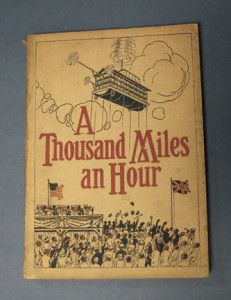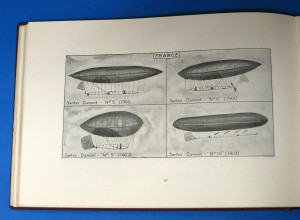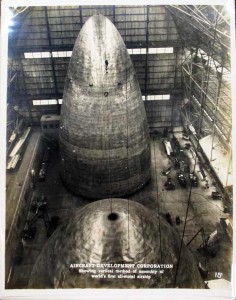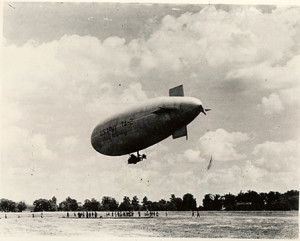I assume all here have heard the humorous (if ridiculously sincere) question, “Where have all the anvils gone?” Cartoons and period films seem to have us convinced that, at one point, anvils outnumbered humans at least 10 to 1. And in the blink of an eye, they vanished. (Spoiler Alert: Of course in reality many were eventually melted down [despite the fact that their whole point was that they wouldn’t melt], and made into more useful things. Like munitions. But opening with that would have ruined this whole blog.) Similar to the anvil is the dirigible. At one point in time, the dirigible was talk of the town, the greatest invention in history. Books were written, pamphlets distributed, and it was the most exciting contraption created. And now? They may not be as popular as they once were, but we’d like to revisit them and show a bit of history from an exciting and creative time in aeronautical engineering.
For those of you that don’t know what a dirigible is, it is an airship. For those of you who don’t know what an airship is, it’s basically a blimp. There is really nothing I can say to those of you who don’t know what a blimp is, because this blog will be lost on you and you might as well exit out of the screen and do something more useful with your time. Like make a sandwich. Or go anvil hunting.
A dirigible, by definition, is a type of lighter-than-air aircraft that navigates through the air under its own power. They gain their lift from large bags filled with a lifting gas that is less dense than the surrounding air. There can be non-rigid, semi-rigid and rigid airships, depending on how structured the inside of the gas filled “envelope” is. The airship was the first aircraft capable of controlled powered flight, a phrase that means it was the first flying transportation device controlled by man inside the vessel (as in, precursor to the airplane).

Original sketch for an aerial ship by “Father of Aeronautics” Jesuit priest Francesco Lana de Terzi in 1670.
As early as 1670, a Jesuit Father named Francesco Lana de Terzi drew up plans for a boat lifted into the air by balloons. In 1785 Frenchman Jean-Pierre Blanchard crossed the English channel with a balloon propelled by a hand-powered propeller and wings and a tail for propulsion and steering. It was not until 1852, however, when French engineer Henri Giffard became the first person to make an engine-powered flight when he flew 17 miles in a steam-powered airship. Once Giffard made that trip, dirigibles turned into the hot new engineering transportation device. By 1878, engineer Charles F. Ritchel made a public demonstration flying his hand-powered one-man rigid airship, and went on to build and sell five of his aircrafts. In 1883 Frenchman Gaston Tissandier (lots of French people were really into airships) attached an electric motor to an airship and went down in history with the first electric-powered flight ever made.

Our holding of A Thousand Miles an Hour – in theory, a great idea, if only slightly* unrealistic!
Airships continued to be developed and advances in the field of aeronautical engineering were seen all over the world. Many inventors and engineers gained funds for their research by advertising on the envelope of the airship (similar to blimps today, displaying Coors Light adverts trailing behind them) or by participating in races and publicity stunts. The craze for airships truly reached its peak in the early 1900s, with Count Zeppelin’s rigid airships and the continuous developments to dirigibles throughout their existence. In a title published in 1913, A Thousand Miles an Hour (which, oh, we just happen to have a copy of for sale), enthusiastic author Robert C. Givins has high hopes and the story centers around an idea that “in 1925… [there is] the invention of an airship which launches itself vertically a short distance into space and achieves its travelling by letting the Earth rotate underneath it” (Locke I, p. 91).

A page of D’Orcy’s Airship Manual – which contains illustrations and photographic reproductions of early airships and those used in the Great War.
Airships proved eminently useful throughout World War I, having been described for that purpose years before the war even began in H.G. Wells’ The War in the Air (published in 1908), where the author speaks of the obliteration of entire fleets and cities by airship attack. Many countries did end up using airships for scouting and tactical bombing roles early on in the war, but by 1917 airship operations directly supporting armies ceased by all countries. Acute curiosity, despite the fear airships presented, prevailed about the use of these aircrafts throughout the war (as their role in bombing, and the inexact way it was carried out during the war, served to truly freak out most citizens of every country), and books such as our D’Orcy’s Airship Manual were published, “to furnish here the most up-to-date information regarding the gigantic fleet of airships built by Germany since the beginning of the Great War, a feature which may, in a certain measure, repay the reader for the utter lack of data on the Allies’ recent airship constructions, which had to be withheld for military reasons.”

The Detroit Aircraft Corporation‘s airship. Caption reads: “Showing vertical method of assembly of world’s first all-metal airship.”
Dirigibles enjoyed almost a century of popularity before World War II sparked further aeronautical developments and a series of airship accidents precipitated its waning popularity. After the end of the Great War, dirigible advancements continued (see photograph to the right of the Detroit Aircraft Corporation’s 1929 metal-clad rigid airship) and although the ships were used once again during World War II and thereafter, mainly for surveillance, and the escorting and organization of troops, a series of accidents leading up to an infamous incident in 1937 sparked an international mistrust of dirigibles for public transportation and entertainment. The Hindenberg LZ-129 (of the Luftschiffbau Zeppelin Company) burst into flames (as it used highly flammable hydrogen gas for lift rather than the safer, but much more costly, helium gas) and crashed mere minutes before approaching the mooring site at the end of its journey. Reporters and citizens were there to record and observe the landing, and instead were treated to a horrific display that resulted in the deaths of 36 of its 97 passengers on board (in reality a smaller death toll compared to some other dirigible disasters, but being caught on film certainly intensified the terror).
However, despite the unpredictability and safety complications involved in the first airships, what was once a source of both wonder and apprehension in spectators has actually been turned into an almost catastrophe-proof platform for communication and transport, mainly due to the use of helium (or even hot air) within the main envelope. Though quite obviously production of dirigibles is not as in demand as say, the production of airplanes, they actually are still in operation and are being manufactured for fresh and interesting uses all the time. In any event, the importance of the dirigible as the first aircraft capable of controlled powered flight – paving the way for all kinds of aeronautical developments – cannot be overlooked. The literature of, manuals for and guides to this great invention have served as inspiration for generations of aviation enthusiasts.
Now if only we could find a manual explaining the extremely suspicious disappearance of all of the anvils in the world…



